Kartik Swami Temple is a beautiful and peaceful journey in the Rudraprayag district of Uttarakhand, India. It is located near Kanakchauri village, along the Rudraprayag-Pokhari road. This hike is not too difficult, and anyone who loves nature, mountains, and spirituality can enjoy it.
The hike leads you to Kartik Swami Temple, which is dedicated to Lord Kartikeya/ Lord Murugan, who is the elder son of Lord Shiva and Goddess Parvati. The temple stands at the height of 3,050 meters or 10,007 feet above sea level. You will get the amazing view of snow-covered Himalayan mountains (Specifically Chaukhamba) from there.
Kartik Swami Temple hike begins at the Kanakchauri Village, a quiet and calm small village. The total hike distance is of 3 kilometres on one side and the whole track passes through the dense woods. The biggest attraction of this hike is the fact that a beginner can very well complete the hike. First-time hikers and adventure seekers wanting a short holiday will not have too much problem hiking over to this spot.

This guide will help you understand everything about the Kartik Swami Temple Trek, including the best time to visit, difficulty level, how to prepare, what to see, and nearby attractions.
Table of Contents
Main Highlights of the Trek
- Location: Rudraprayag District, Uttarakhand, India
- Starting Point: Kanakchauri Village
- Trek Distance: 3 kilometers (one way)
- Maximum Altitude: 3,050 meters (10,007 feet)
- Trek Duration: 2 to 3 hours (one way)
- Difficulty Level: Easy to Moderate
- Best Time to Visit: March to June, September to November
What Will You See During the Trek?
It’s a 3-kilometer trek that will take you through a beautiful forest. The path is covered with trees, colorful flowers, and fresh mountain air. Along the way, you’ll see small wooden benches where you can rest. There are also spots to take pictures of the mountains and the valleys below.
You will experience the chirping of birds and the cool breeze on your face. When you see the temple, the whole mountain range of the Garhwal Himalayas is thrown open in front of your eyes. On clear sky days, you can actually see some of the tallest Indian peaks.
Detailed Itinerary
This 4-day itinerary will walk one through the journey from Rishikesh or Haridwar to Kanakchauri village, trek to the temple, and return journey. It is easy to moderate with trekking for beginners as well as experienced trekkers.
Day 1: Arrival in Rishikesh or Haridwar
- Starting Point: Rishikesh or Haridwar
- Activities: Exploring local markets, temples, and preparing for the trek
- Accommodation: Hotel or guesthouse
The journey begins in Rishikesh or Haridwar, two famous spiritual cities in Uttarakhand. Both cities are well connected by trains and roads, making them easy to reach. Rishikesh is also known as the “Yoga Capital of the World”, while Haridwar is an important pilgrimage site.
Things to Do Before the Trek
- Local markets will be visited to purchase trekking gear, such as warm clothes, trekking poles, and waterproof boots.
- Temple and ashram visits will be made for a spiritual experience.
- You can spend time at the Ganga ghats and enjoy the famous Ganga Aarti in the evening.
- Spend the day in Rishikesh or Haridwar, and rest in a hotel or guesthouse for the night because the next day is a long drive to Kanakchauri village.
Day 2: Drive from Rishikesh to Kanakchauri Village
- Distance: Approximately 200 km
- Time taken: 6-7 hours by road
- Route: Rishikesh → Devprayag → Srinagar → Rudraprayag → Kanakchauri
- Altitude: 1,500 meters (4,921 feet)
The drive to Kanakchauri Village is long but very scenic. Hiking over the path, one can see dense forests, river valleys, and snow-capped mountains. This journey also passes through Devprayag (one of the Panch Prayag), a special place where the rivers Alaknanda and Bhagirathi meet to form the holy Ganga river.
What Will You Get Along the Way?
- Small roadside shops sell tea, snacks, and food.
- Breathtaking views of green valleys and the Ganga and the Alaknanada.
- Dhari Devi Temple in Srinagar and Rudranath Mahadev Temple in Rudraprayag
Upon reaching Kanakchauri, the village is peaceful and surrounded by forests and mountains. The nature of the slope is gentle, making it easy to explore the area. Spend the night in a homestay or guesthouse and prepare for the next day’s trek.
Day 3: Trek from Kanakchauri to Kartik Swami Temple and Back
- Trek Distance: 3 kilometers (one way)
- Duration: 2-3 hours trek each way
- Altitude ascent: 500 meters (1,640 ft)
- Trail types: Well-defined forest trails stone paved
- Grade: Easy
Beginning the Hike
- Trekkers ascend on the path from Kanakchauri village. The nature of the terrain is largely forested with dense oak and rhododendron trees along the path.
- Within a few minutes of crossing the village, the forest becomes denser, and the sounds of birds chirping fill the air.
Halfway Point
- The trees begin to open up after an hour of walking and uncover the valley that lies below.
- Dense vegetation lines this trail such that it seems like a walk through an untouched paradise.
- You will also see resting spots with benches where you can sit and take in the beauty of the mountains while hiking, which adds to the experience of hiking.
Final Leg of the Trek: The Walk to the Temple
- Hike along the trail, and the final leg of the hike is using stone steps to climb up to the temple
- This section is more steeply sloped but not too challenging; however, it can test your fitness if you are not well prepared.
- You will need to carry enough food and water for this day as there are no shops near the temple.
View of Kartik Swami Temple
- Upon reaching the summit, Kartik Swami Temple is located on the right.
- The temple is surrounded by a lot of thousands of bells, tied by devotees as an expression of faith.
- The view from here is fabulous. You can have a glimpse of Chaukhamba, Kedarnath, Neelkanth, Trishul, and many more Himalayan peaks.
- It is deep in its meaning because of the peaceful ambiance that makes it an ideal place for meditation and prayer.
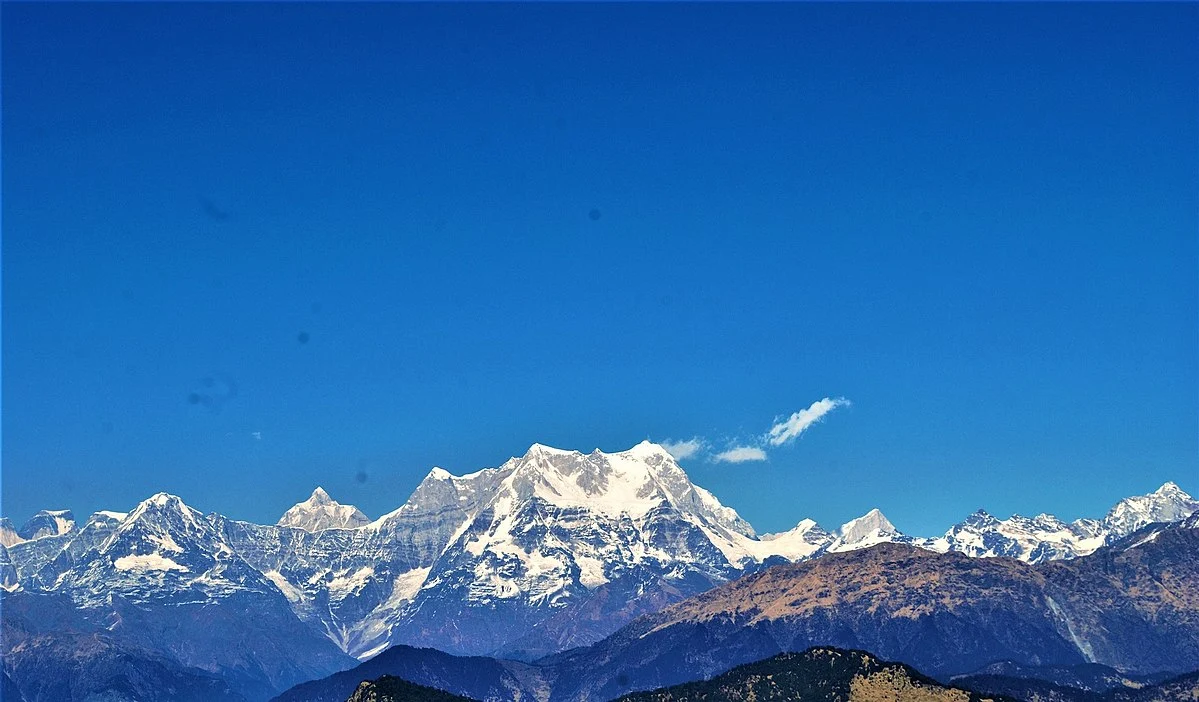
Start trekking back to Kanakchauri, enjoying the beautiful view during the trek back.
Day 4: Return Journey
- Drive from Kanakchauri to Rishikesh
- Total Distance: 200 kilometers
- Time Taken: 6-7 hours
Leave Kanakchauri after breakfast and head back to Rishikesh or Haridwar. The road is the same as the return route, following the same course through Rudraprayag, Srinagar, and Devprayag.
Points to Note on the Return Journey
- On the way, you will pass scenic view points for your final Himalayan views.
- Local cuisine can be savored at the dhabas and restaurants en route.
- By late evening, reach Rishikesh or Haridwar and either spend the night or continue your return journey home.
How to Reach
Air
The nearest airport to Kanakchory is Jolly Grant Airport, Dehradun, which is around 190 km away. You will easily get a direct flight to Dehradun from Tier 1 and Tier 2 cities. Just in case if direct flight is a bit expensive, then take the flight to Delhi and after that reach Dehradun.
Rail
The nearest railway stations to Kanakchory are Yog Nagri Railway Station, Rishikesh, and Haridwar Railway Station, which are 175 km and 198 km away, respectively. Most of indian cities are connected to these railway stations.
Road
After you have reached the airport or railway station, you can either hire a private cab or opt for public transportation.
Get an early morning bus from Rishikesh to Rudraprayag. The fare would be around INR 300. Once you are in Rudraprayag, take a local taxi to Kanakchauri.
Best Time to Visit the Kartik Swami Temple Trek
The Kartik Swami Temple Trek is a beautiful journey that looks different in every season. Some people like pleasant weather and flowers, while others enjoy cold and snow. The best time to visit depends on what kind of weather and views you like. Each season has something special to offer.
Spring & Summer (March to June)
- Temperature: 15°C to 25°C
- Weather: Warm, clear skies, and colorful flowers everywhere.
- Clothing Needed: Light jacket for the morning and evening, trekking clothes that are comfortable, and good walking shoes.
- Recommended For: First-time trekkers, nature lovers, photographers, and families.
Scenic View and Experience
During spring and summer, the entire trekking path looks colorful. Red and pink rhododendron flowers bloom on both sides of the trail, making it look like a beautiful painting. The weather is not too hot and not too cold, making it perfect for walking. The skies are blue and clear, so you can see faraway mountain peaks without any mist or fog.
This is the most appropriate season for first-time trekkers as the track is dry and can be easily trekked on. No snow or slippery track exists that might make it risky and inconvenient for people. For bird enthusiasts, this season will be excellent since many colourful birds are spotted inside the trees.
Difficulty and Precautions
This is an easy time to trek in this season; however, there is a requirement to carry a good amount of water because hiking in warm climate conditions can drain you out easily and make you thirsty.
Wear light clothes and carry a light jacket because at times it will get a bit cold in the morning and the evening.
Autumn (September to November)
- Temperature: 10°C – 20°C
- Weather: Cool, Fresh air, and very clear Mountain views.
- Clothing Needed: Warming up jackets for the evening, comfortable trekking pants, and good walking shoes.
- Best For: Pilgrims, adventure enthusiasts, and photographers.
Scenic Beauty and Experience
Autumn is a very good season for trekking as the climate is cool and the air is fresh. The dust washed away from the sky makes it super clear due to rain during the monsoon season. The Himalayas look very sharp and bright without any mist around them. Leaves of trees turn golden and orange in color and make the forest look magical.
This is a good season for pilgrims who wish to visit the temple since the weather is comfortable for prayers and meditation. People who love peace and quiet will also enjoy this season since fewer tourists come compared to summer.
Difficulty and Precautions
The trek is easy to moderate in this season. The path is dry and safe, but it becomes chilly in the morning and evening, so warm clothing will be required. Gloves and a cap would be a good idea as it is windy.
Winter (December to February)
- Temperature: 0°C to 10°C
- Weather: Very cold, due to snow-covered trails and misty mountain views.
- Clothing Needed: A Thick winter jacket, woolen gloves, thick socks, and waterproof shoes
- Best For: Experienced trekkers who have a liking towards snow and adventure.
Scenes and Experience
Winter makes Kartik Swami Temple Trek one of the finest white paradises. The snowy cover on all the trees and trails, accompanied by the shrouded look of the temple, looks straight out of postcard pictures. The air smells fresh, while the mountains beneath the soft glows of the sun look simply exquisite.
It is perfect for people who love snow trekking because the whole trail looks magical when it’s under snow. But not many people come here during the winter season. If you prefer quiet and peaceful surroundings, then this is the best time to visit.
Difficulty and Precautions
Winter trekking is challenging and suitable only for experienced trekkers. The trail can be slippery, and walking in deep snow can be challenging. Thick warm clothes must be worn and trekking poles are a necessity for support. Snow boots must be worn while walking. Sometimes the temperature freezes to a freezing level, and it is quite helpful to carry hot water in a flask.
Which Season is Best for You?
| Season | Best For | Weather | Difficulty Level | Special Features |
| Spring & Summer (March to June) | Beginners, Families, Nature Lovers, Photographers | Warm, clear skies, colorful flowers | Easy | Rhododendron flowers, pleasant temperatures, clear mountain views |
| Autumn (September to November) | Pilgrims, Adventure Seekers, Peace Lovers | Cool, fresh air, very clear views | Easy to Moderate | Golden forests, no mist, peaceful trekking experience |
| Winter (December to February) | Experienced Trekkers, Snow Lovers | Very cold, snowy landscapes | Difficult | Snow-covered temple and mountains, quiet and peaceful atmosphere |
Difficulty Level of the Kartik Swami Temple
It falls under Easy to Moderate-grade treks and thus is pretty appropriate for either novices and expert trekkers. With few factors playing against the severity level, some might need due attention before visiting it.
Difficulty-affected factors:
- Terrain: The route is adequately signposted with hardly any loss in navigation and some narrow paths with high slope levels, one being really close to steep pitches. These latter parts, which consist of stoned steps, approach to the Kartik Swami temple.
- Walking Distance: Hike is approximately 3 km one way (6 kms both ways). Everybody can complete a hike in the time range between 2 hours to 3 hours.
- Weather Conditions: This trek is easy in summer and autumn, especially during periods of clear and dry weather. In winter, the trail becomes slippery under the snow and becomes more challenging. The monsoon time during July-August is not advisable for trekking as the path can be muddy and challenging.
- For the majority of people, good fitness levels and basic preparation are sufficient enough for the completion of this trek without any sort of problem.
Additional Facts About the Kartik Swami Temple
The temple apart from the trek also has rich aspects of culture, history, and wildlife. Here are some further points of understanding of cultural values, biodiversity, and more additional places that lie around the trek.
Cultural & Historical Information
This temple is dedicated to Lord Kartikeya, who is the elder son of Lord Shiva and Goddess Parvati. It is a very special and holy place for those devotees who come here to pray and seek blessings.
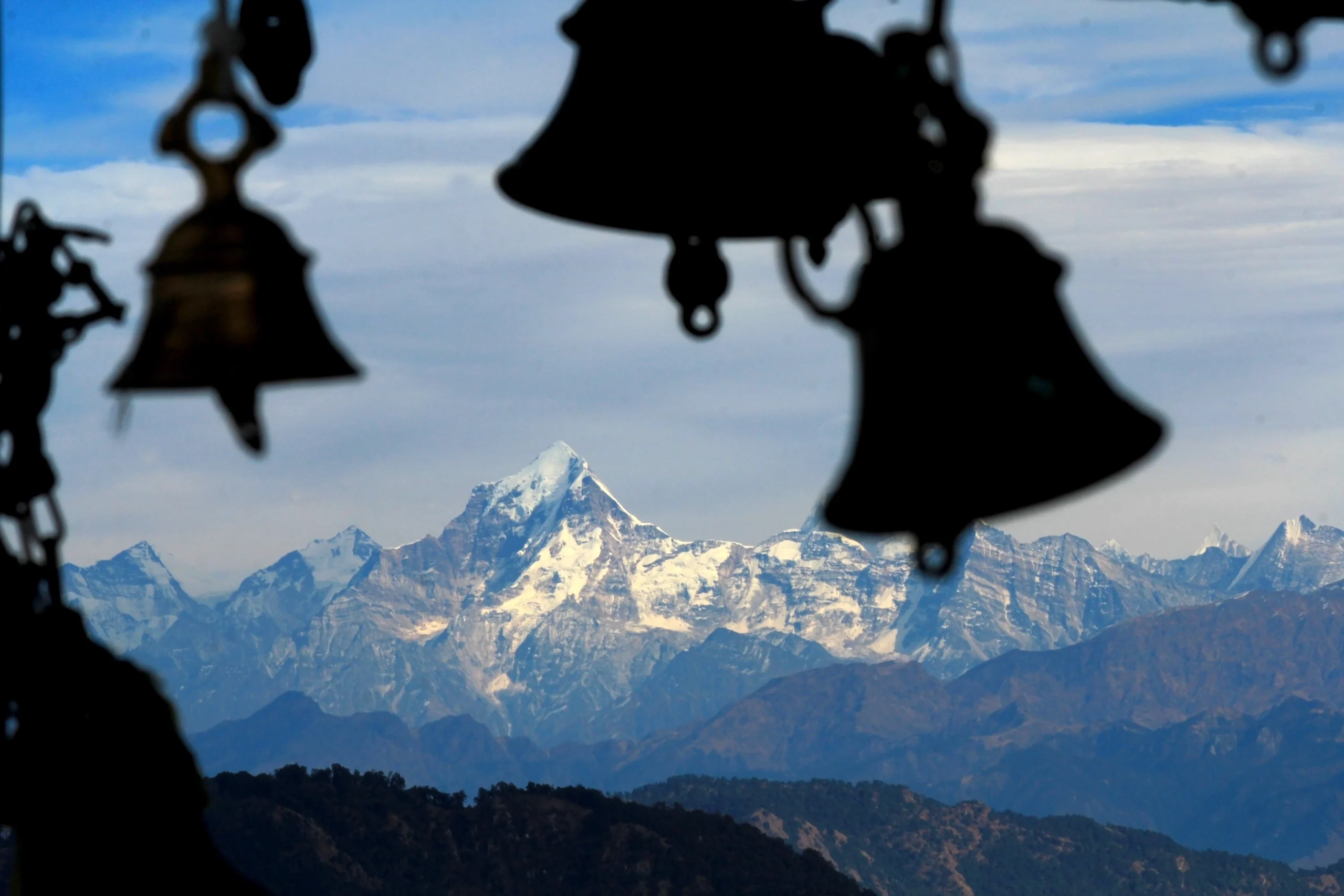
Religious Story
A long time ago, Lord Shiva presented a challenge to his two sons, Kartikeya and Ganesha. He told them to go round the universe and come back. The first to finish will be worshipped first.
- Kartikeya took his peacock and flew all around the universe.
- Ganesha was a smart fellow. He simply went round his parents and said, “For me, my parents are my whole universe.”
- Lord Shiva was satisfied with Ganesha’s knowledge and granted him the first rank in worship.
Kartikeya was distressed and renounced everything, even offering his body to Lord Shiva. The people believe that his bones were dropped at this particular place, and this temple is constructed in his name. This temple reminds us of love, devotion, and sacrifice.
Temple and Traditions
The Kartik Swami temple is simple but very powerful. Thousands of bells are tied around it by devotees as prayers and wishes. People come here to pray for strength, courage, and wisdom.
Special prayers take place on Kartik Purnima and Skanda Sashti, which are important days for the worship of Lord Kartikeya. The temple is also a very peaceful place where saints and spiritual seekers come to meditate and find inner peace.
This is not only a religious place but also a place of calmness and deep devotion. Many people visit to feel the divine energy and enjoy the quiet beauty of the mountains.
Flora & Fauna
The Kartik Swami Temple Trek passes through lush green forests, rolling meadows, and high-altitude landscapes, making it rich in biodiversity.
Flora (Plants & Trees)
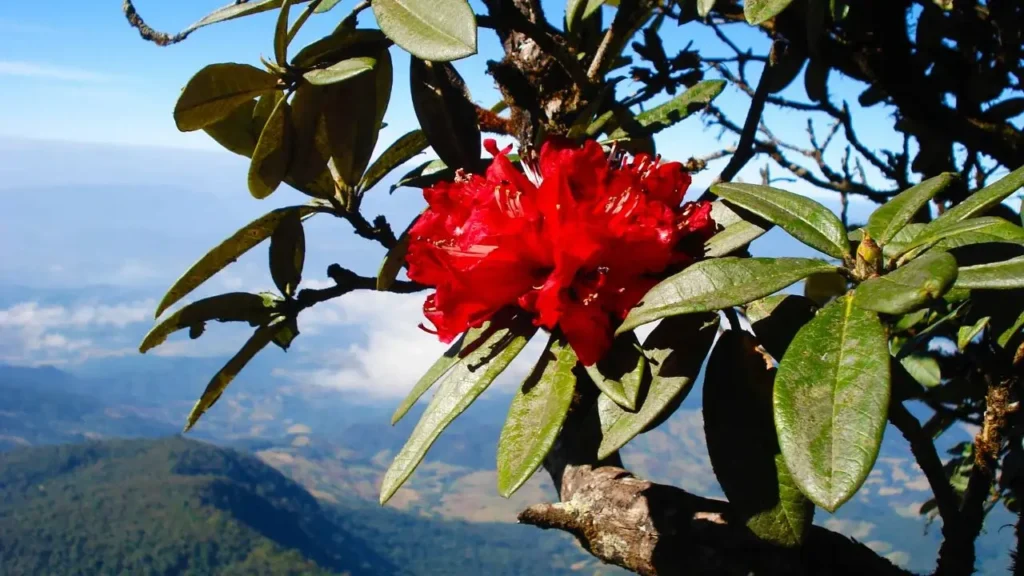
- Rhododendron Trees – Bloom in March and April, covering the forest in red and pink flowers.
- Oak & Deodar Trees – Along the trekking routes, it is covered with shades & pure air
- Alpine Meadows – The upper altitudes are full of lush, emerald green meadows in summer and autumn
- Herbs & Medicinal Plants- Used in Ayurveda, and occur naturally in the locality
Fauna (Wildlife & Birds)
- Himalayan Monal –State bird of the Uttarakhand State, richly colored & beautiful.
- Barking Deer-The shy and quite rarely seen along the forest.
- Himalayan Langur- Swings from tree to tree in a forest.
- Eagles and Vultures- Large-sized birds circling around the temple
- Butterflies & insects- The area boasts many beautiful species of butterflies which abound in plenty, especially spring and summer.
Through the diverse natural landscape, visitors will be able to experience adventure with a deep sense of connection to nature.
Nearby Attractions
Besides the Kartik Swami Temple, there are a lot of other beautiful places close to the trek that visitors can visit.
1. Tungnath Temple
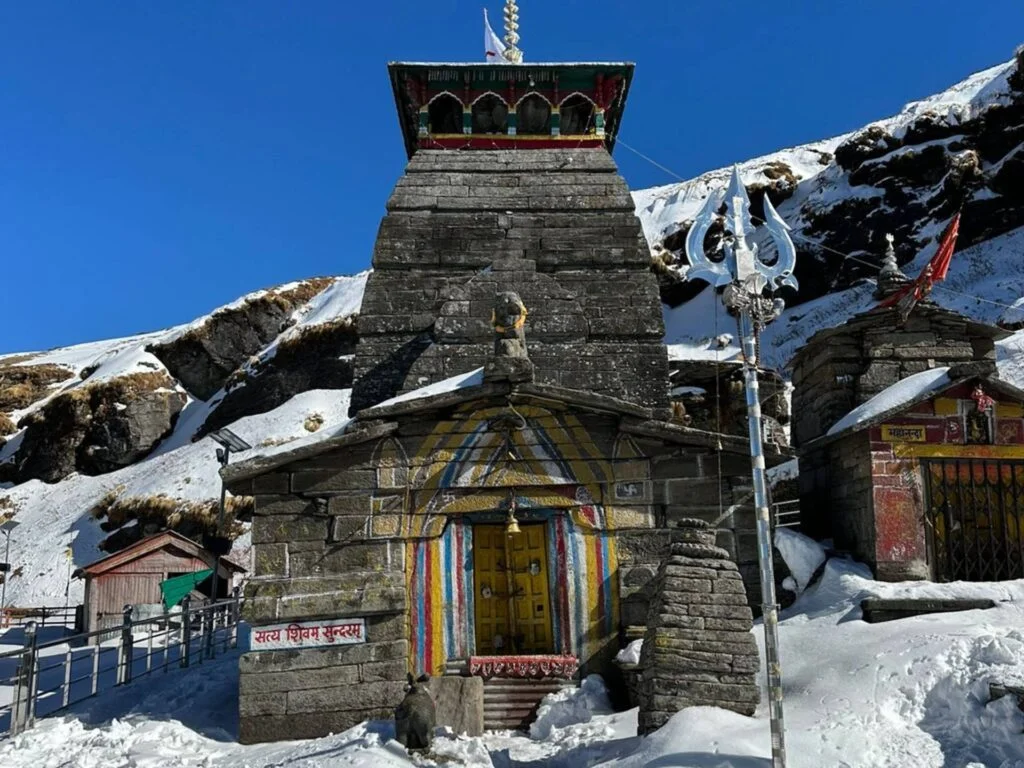
At an altitude of 3,680 meters (12,073 feet) in Chopta, this temple stands tall as the world’s highest Shiva temple. These temples constitute Panch Kedar and are dedicated to Lord Shiva. Although a short but steep trek, the sightseeing towards snow-covered mountains is simply breathtaking.
2. Chandrashila Peak
A famous trekking destination with an altitude of 4,000 meters (13,123 feet). It is known for its breathtaking sunrise views over the Himalayas. Trekkers can see Nanda Devi, Trishul, Kedar Dome, and Chaukhamba peaks from the top.
3. Chopta
Chopta often referred to as the “Mini Switzerland of India” because of its lush green meadows and pine forests, it is ideal for camping and trekking, offering stunning views of the Himalayas. It is also home to a variety of Himalayan birds and wildlife.
The following are the exciting attractions around this place that add to the thrill of a journey to Kartik Swami Temple Trek. Visiting these stunning places during this trek would allow visitors to complete their adventure and spiritual journey.
Conclusion
The Kartik Swami Temple Trek is particularly suitable for nature lovers, adventure seekers, and spiritual travelers. It is easy, short, and offers a stunning view of the Himalayas. With its silent environment, rich history, and breathtaking scenery, such a trek is an unforgettable experience.
Proper planning, suitable clothing, and basic fitness levels are necessary for an enjoyable experience. The trek’s short distance and well-defined paths make it accessible, while the spiritual ambiance of the temple enhances the overall journey.
You can opt for the Chopta and Kartik Swami Tour. We also customise the trip according to the client’s needs. If you want to opt for that, then please connect with us at info@himalayandreamtreks.in or call us at +91 80896 93825.
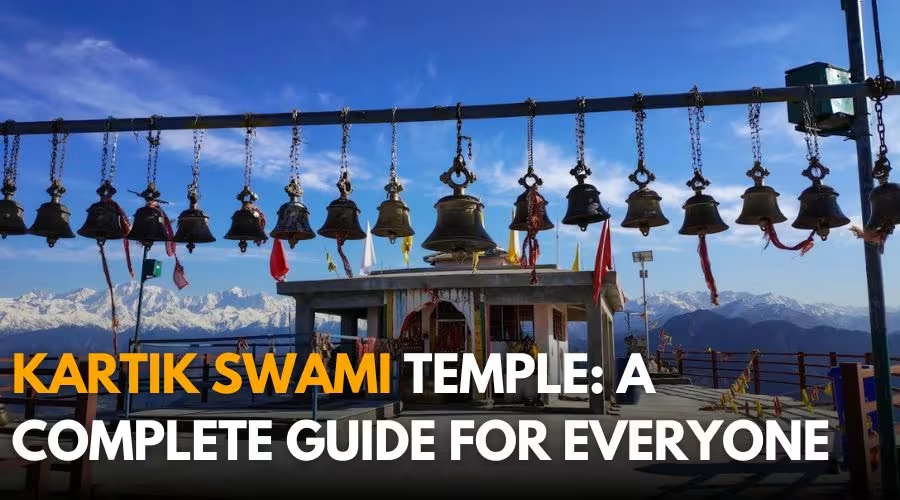
Leave a Comment